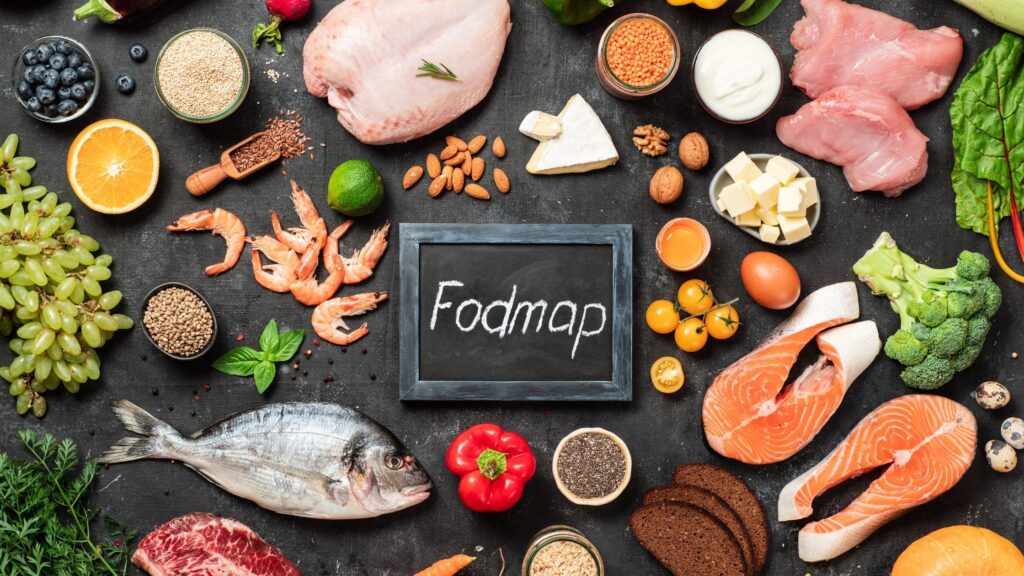The Secret to using a Low FODMAP diet for IBS

The Top Reason this Dietitian recommends a Low FODMAP diet meal plan for IBS
In 2010, the low FODMAP diet was discovered in Melbourne, Australia by researchers at Monash University. They found that restricting foods high in FODMAPs brought relief to common IBS symptoms like abdominal pain, bloating, flatulence (gas) and diarrhea.
The science behind this temporary meal plan included multiple randomized controlled trials (the gold-standard for research) that compared the low-FODMAP protocol with various other treatments for people with IBS.
Over the last decade, the low FODMAP diet continues to prove that it improves IBS symptoms for up to 75% of people who follow the three-phase plan.
This is the reason why the low-FODMAP meal plan is part of my “Build a Better Gut” five-step protocol.
What Exactly are FODMAP’s?
FODMAPs are different types of carbohydrate. Therefore, protein and fats do not contain FODMAPs. When food that contain FODMAPs aren’t absorbed properly in the gut they trigger IBS symptoms of abdominal bloating, distention and gas production.
FODMAP is an acronym for:
Fermentable—meaning they are broken down (fermented) by bacteria in the large intestine creating abdominal distention and hydrogen gas.
Oligosaccharides— these are individual sugars joined together to create a chain. Examples include cereals, pasta, breads and legumes.
Disaccharides—’di’ means two individual sugars bonded together. An example is milk sugar or lactose which is two oligosaccharides glucose and galactose that come together to make a disaccharide.
Monosaccharides—’mono’ means single so this is a single sugar molecule. Certain fruits, vegetables, and sweeteners are naturally abundant in monosaccharides and contribute to the symptoms of IBS. Examples are varied, from apples to honey!
And …
Polyols—small chains of carbohydrates naturally found in certain fruits, vegetables and used as food additives. Polyols, also called sugar alcohols, are frequently used to replace sugars to provides sweetness. Examples in foods are varied from apples to honey and the low-calorie sweetener sorbitol.
First, FODMAPs are made up of chains of sugar molecules, they can ferment in the small intestine. Fermentation in the small intestine pulls in extra water causing abdominal pain and distention.
Second, in addition to their effect on the small intestine, FODMAPs serve as food for the bacteria that lives in the large intestine (colon). The end result of this feeding frenzy is the production of gas.
Between the poor absorption in the small intestine and the fermentation that occurs in the large intestine, the result is the sensation of abdominal pain and bloating.
Lastly, contractions of muscles found in the wall of the bowel may lead to diarrhea in some people or constipation in others.
Temporarily using a low FODMAP meal plan can reduce the excess water and fermentation in the intestines. However, the low FODMAP meal plan is not a cure for IBS. The goal is NOT to follow a low FODMAP meal plan for life.
One of the challenges with a low FODMAP meal plan is that excludes many nutrient-rich foods. Plus, many high FODMAP foods are food for beneficial bacteria found in the colon.
Yet using the 3-step FODMAP process provides a way to identify foods that are triggering the symptoms.
Low-FODMAP Diet is not a Life Long Commitment
A low FODMAP meal plan is not a diet meant to follow for months on end.The goal of following a low FODMAP meal plan protocol is to discover your trigger foods and return to eating a wider variety of foods without fear of triggering IBS symptoms.
Below is a breakdown of the three phases:
Phase 1: Elimination phase.
This is the most difficult phase since this initial phase is when you swap out high FODMAP foods for low FODMAP foods. This phase can last between 2-6 weeks with the goal to reduce symptoms. An example is swapping an apple for a kiwi or chives for white onions.
Phase 2: Challenge phase.
This phase can be tedious but is where the person can discover the foods that trigger symptoms. During the next 4-6 weeks there is a systematic process for re-introducing higher FODMAP foods.
For example, the person will have a specified serving from one of the FODMAP groups (Fructose, Fructans, Polyols, etc.) for three days in a row. Then there is what is called a “washout” period of 1-5 days where no new higher FODMAP food is reintroduced.
Then a new food from another higher FODMAP group is tried for three days with a washout period. The process continues to repeat itself until all the FODMAP groups or foods under each group have been reintroduced.
The process takes time, energy, and patience to determine each person’s trigger foods. During Phase 2 the person continues to follow a lower FODMAP meal plan to avoid triggering symptoms.
Phase 3: Adapted phase:
This is the enjoyable phase! After going through the challenge phase the person now has a blueprint of the foods they can enjoy without fear of symptoms.
This can still be daunting to figure out. That’s why having a meal plan created by a Registered Dietitian specializing in gut health and FODMAP-trained has been shown to lead to greater success.
Having a personalized eating plan, using a mixture of naturally low FODMAP foods and identified high FODMAP trigger foods, increases the variety of foods in the diet which overall is always better for gut health.
Reasons why the Low FODMAP diet doesn’t Work for Everyone
Unfortunately, while the low FODMAP diet is highly effective it doesn’t always provide relief for some people. Research shows it doesn’t reduce symptoms for 1 in 4 people.
Taking a deeper dive into the lack of success with the low FODMAP meal plan includes that that some people didn’t strictly adhere to the meal plan guidance. Or some didn’t give the elimination phase enough time to work.
However, there are some who will not improve despite doing everything correctly. These individuals need further work up to rule out small intestinal bacterial overgrowth (SIBO) through breath testing.
Some people have other reasons for their symptoms such as a histamine intolerance; conditions such as sucrase isomaltase deficiency (SID), or the non-food trigger of the gut-brain chatter that contributes to their IBS symptoms. This is a reminder that food is only one factor contributing to the symptoms of IBS.
Read this before starting the low-FODMAP diet
The low-FODMAP three-phase protocol is complex. The detailed educational component can be provided by a gut-health Dietitian to ensure that their meals are nutritionally complete.
Putting into practice a poorly understood low FODMAP protocol can lead to deficiencies in vitamins, minerals and protein. Plus, the results will be misleading.
The biggest concern is that eliminating higher FODMAP foods that serve as food for the desirable bacteria in the gut actually can change the microbiome for the worse.
The need for a systematic way of reintroducing FODMAPs in phase two is the lynchpin to success. This is likely the phase which is most difficult to put into place and interpret without expert guidance.
Beyond nutritional deficiencies, the concern that people can become obsessive with what and how much they eat of certain foods, is another concern. Even with short-term restrictions, such as those in the low-FODMAP meal plan, people easily can develop an obsession with their food choices.
Key points on low-FODMAP diet
- A low-FODMAP diet won’t ‘cure’ IBS.
The goal of completing the three phases of the low-FODMAP protocol is to discover the higher FODMAP foods that trigger symptoms and to expand the persons food choices. Continued clinical research shows up to a 75% success rate for significantly reducing or eliminating the symptoms of IBS.
- Following the Low-FODMAP protocol is not an easy DIY project.
Successfully completing all three phases of the low-FODMAP protocol is best when done under the guidance of a Registered Dietitian trained in the Monash FODMAP protocol. Having a RD helps with navigating the subtleties of the plan.
While there are useful resources available, from the Monash University FODMAP app to the FODMAP Friendly app, these should not replace the specialized and personalized advice of a FODMAP trained Dietitian.
- Not everyone will find the low-FODMAP protocol will reduce their IBS symptoms.
One in four people will not find a difference in their symptoms when they follow a low-FODMAP meal plan.
If the person follows the protocol as directed yet doesn’t find relief, looking at other causes for the symptoms is the next step. This may include ruling out Small Intestinal Bacterial Overgrowth (SIBO) using an at home breath test.
In conclusion …
The low-FODMAP protocol is one of several tools to reduce or eliminate symptoms of IBS. If the low-FODMAP protocol doesn’t produce the expected results, look at other root causes for symptoms such as SIBO, SID, histamine intolerance or an over-activated stress response.
Given that the symptoms of IBS directly affect the quality of everyday life for millions, trying the low-FODMAP protocol is a low-risk plan that can pay off with big benefits.
This is part of a series of articles on the low-FODMAP diet. If you’re looking for ideas of low-FODMAP recipes for breakfast, Click Here to sign up for your copy of “Kick your Day Off with 5 Easy-to-Make Breakfast Recipes to Manage IBS Symptoms.”


